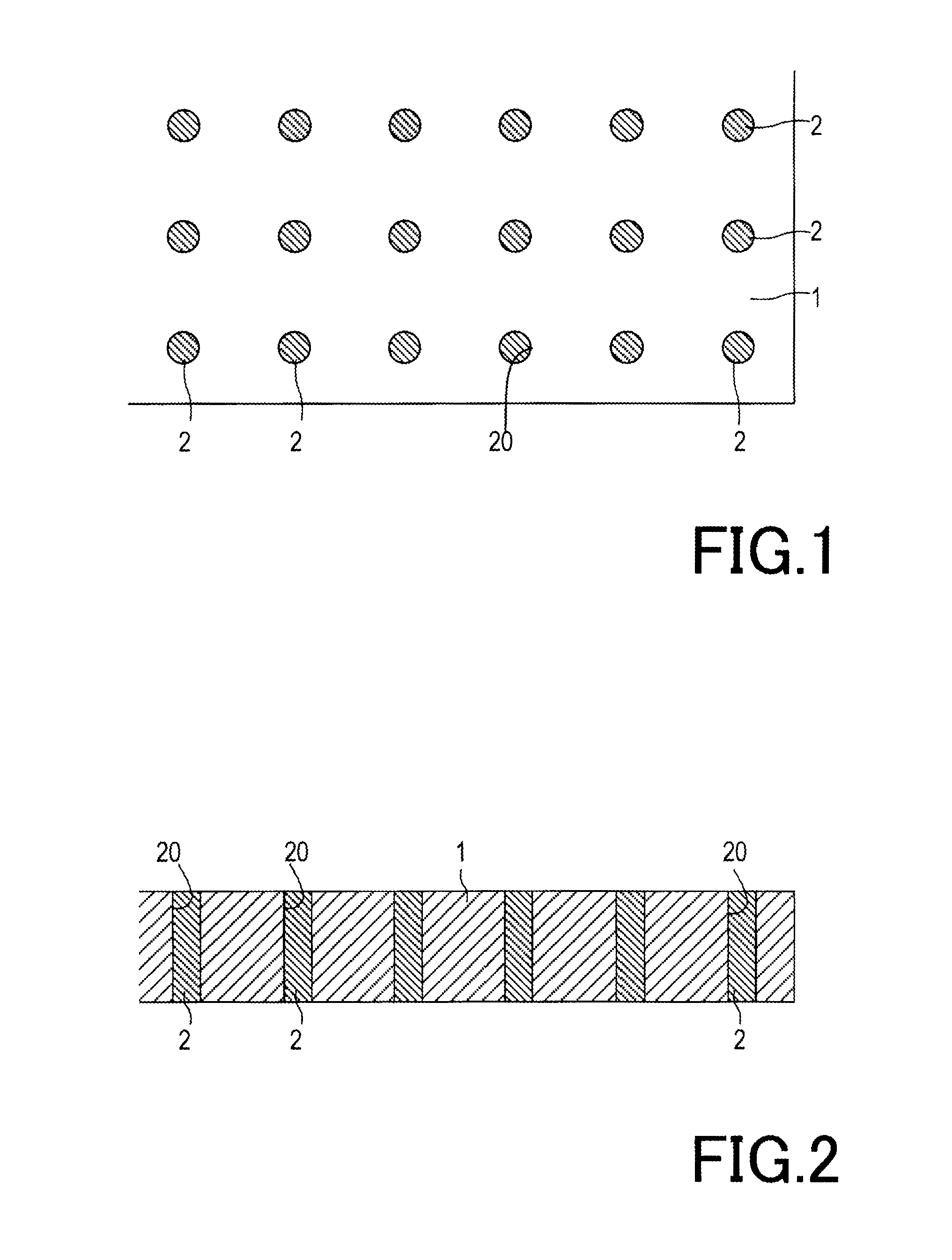Substrate for electronic device and electronic device
a technology for electronic devices and substrates, applied in the field of substrates for electronic devices and electronic devices, can solve the problems of increasing signal delay, increasing mounting area, and reducing production efficiency of electroplating, and achieve excellent heat dissipation characteristics
- Summary
- Abstract
- Description
- Claims
- Application Information
AI Technical Summary
Benefits of technology
Problems solved by technology
Method used
Image
Examples
embodiment 1
Light-Emitting Diode and Light-Emitting Device
[0125]A light-emitting device shown in FIGS. 10 to 12 comprises a substrate 1 and a light-emitting element 6. The light-emitting element 6 is covered with a fluorescent layer 7. The substrate 1 serves as a so-called package, includes two through electrodes 2, 2 and a number of columnar heat sinks 3 and has a cavity 11 at one side thereof. Preferably, the substrate 1 includes Si as a main component. Alternatively, the substrate 1 may be an insulating resin substrate or an insulating ceramic substrate. In the figures, the substrate 1 has a rectangular outline but its shape is arbitrary. The cavity 11 of the substrate 1 is formed to surround the through electrodes 2, 2 at a distance, wherein a reflection film 8 such as an Al film, an Ag film or a Cr film is formed almost all along its inner side face by sputtering or the like. It is also possible to form an insulating film such as an oxide film beneath the reflection film 8.
[0126]The throug...
embodiment 2
Electronic Device or Electronic Equipment
[0189]The electronic element is not limited to the foregoing light-emitting element 6 but may be an active element, a passive component or a composite element thereof. It may also be one having the above-described various types of elements arranged into a three-dimensional multilayer structure based on the TSV technology or one having an interposer and the various types of elements combined into a three-dimensional multilayer structure.
[0190]Referring to FIG. 27, there is illustrated a circuit substrate suitable for mounting such an electronic element. In this figure, the components identical or similar to those illustrated in the foregoing figures are denoted by the same reference symbols. In FIG. 27, the number of through electrodes 2 is increased in accordance with the number of terminal electrodes of an electronic element to be mounted within the cavity 11. In addition, the cavity 11 has an inner side face extending substantially vertical...
embodiment 3
Other Devices
[0219]Referring to FIG. 33, there is illustrated a substrate having a number of columnar heat sinks 3. In this substrate 1, the tip of the columnar heat sink 3 is kept within a heat-resistant insulating organic or inorganic substrate 1, thereby leaving an insulating layer having a thickness of ΔH1 above it. That is, the columnar heat sink 3 is not required to pass through it. The thickness of ΔH1 can be determined arbitrarily.
[0220]Referring next to FIG. 34, there is illustrated a substrate 1 comprising an organic insulating substrate. The organic substrate 1 preferably comprises a heat-resistant material. Particularly preferred is one having a heat resistance of 300° C. or more. The organic substrate 1 has, on at least one side thereof, a metal layer 31, 32 such as of a Cu foil. The illustrated organic substrate 1 is a double-sided copper-clad substrate having the metal layers 31, 32 of a Cu foil on both sides thereof. Various types of such a double-sided copper-clad s...
PUM
| Property | Measurement | Unit |
|---|---|---|
| aspect ratio | aaaaa | aaaaa |
| length | aaaaa | aaaaa |
| length | aaaaa | aaaaa |
Abstract
Description
Claims
Application Information
 Login to View More
Login to View More - R&D
- Intellectual Property
- Life Sciences
- Materials
- Tech Scout
- Unparalleled Data Quality
- Higher Quality Content
- 60% Fewer Hallucinations
Browse by: Latest US Patents, China's latest patents, Technical Efficacy Thesaurus, Application Domain, Technology Topic, Popular Technical Reports.
© 2025 PatSnap. All rights reserved.Legal|Privacy policy|Modern Slavery Act Transparency Statement|Sitemap|About US| Contact US: help@patsnap.com



